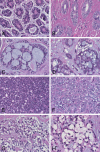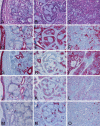Morphological heterogeneity of oral salivary gland carcinomas: a clinicopathologic study of 41 cases with long term follow-up emphasizing the overlapping spectrum of adenoid cystic carcinoma and polymorphous low-grade adenocarcinoma
- PMID: 21577319
- PMCID: PMC3093058
Morphological heterogeneity of oral salivary gland carcinomas: a clinicopathologic study of 41 cases with long term follow-up emphasizing the overlapping spectrum of adenoid cystic carcinoma and polymorphous low-grade adenocarcinoma
Abstract
We analyzed 41 oral salivary gland carcinomas from consecutive 290 salivary gland carcinoma database (14%) with emphasis on the histological spectrum and clinical outcome of adenoid cystic carcinoma (ACC) and polymorphous low-grade adenocarcinoma (PLGA). The cohort included 14 ACCs, 14 mucoepidermoid carcinomas (MECs), 8 PLGAs, 3 adenocarcinomas, not otherwise specified and 2 acinic cell carcinomas. Mean age was 48, 58 and 61 yrs for ACC, MEC and PLGA, respectively. Eight patients (19.5%) died of tumor at a mean interval of 66.5 months. ACC and PLGA showed similar mean age, gender distribution, predominant palatal localization, nodal metastasis, perineural invasion and MIB-1 index. However, ACC tended to show higher tumor stage and residual tumor (R1/R2) more frequently than PLGA, but this was statistically not significant. ACC and PLGA showed overlapping architectural patterns. However, ACCs displayed well organized basal-luminal differentiation, highlighted by CK5/CK7 immunostaining. In contrast, PLGA showed a disorganized histological and immunohistological pattern. C-Kit expression (CD117) was common in ACC, generally mirroring that of CK7 and virtually lacking in PLGA. Kaplan-Meier analysis demonstrated a similar clinical course for ACC and PLGA with 5 years survivals of 87% and 80%, respectively. Fluorescence in situ hybridization (FISH) performed on all 290 salivary carcinomas confirmed the specificity of the translocation t (11; 19) for MEC and its absence in all other carcinomas including ACC and PLGA. Our results emphasize the diversity of oral salivary gland carcinomas and the overlapping clinicopathological features of ACC and PLGA.
Keywords: Oral salivary gland carcinoma; acinic cell carcinoma; adenoid cystic carcinoma; polymorphous low-grade adenocarcinoma.
Figures





Similar articles
-
C-kit expression in the salivary gland neoplasms adenoid cystic carcinoma, polymorphous low-grade adenocarcinoma, and monomorphic adenoma.Oral Surg Oral Med Oral Pathol Oral Radiol Endod. 2003 May;95(5):586-93. doi: 10.1067/moe.2003.31. Oral Surg Oral Med Oral Pathol Oral Radiol Endod. 2003. PMID: 12738950
-
Assessment of p63 expression in the salivary gland neoplasms adenoid cystic carcinoma, polymorphous low-grade adenocarcinoma, and basal cell and canalicular adenomas.Oral Surg Oral Med Oral Pathol Oral Radiol Endod. 2004 May;97(5):613-9. doi: 10.1016/S1079210403005742. Oral Surg Oral Med Oral Pathol Oral Radiol Endod. 2004. PMID: 15153875
-
Cytogenetic similarities between two types of salivary gland carcinomas: adenoid cystic carcinoma and polymorphous low-grade adenocarcinoma.Cancer Genet Cytogenet. 2001 Jul 15;128(2):130-6. doi: 10.1016/s0165-4608(01)00416-2. Cancer Genet Cytogenet. 2001. PMID: 11463451
-
Adenoid cystic carcinoma with high-grade transformation: a report of 11 cases and a review of the literature.Am J Surg Pathol. 2007 Nov;31(11):1683-94. doi: 10.1097/PAS.0b013e3180dc928c. Am J Surg Pathol. 2007. PMID: 18059225 Review.
-
Polymorphous low-grade adenocarcinoma and adenoid cystic carcinoma: a review and comparison of immunohistochemical markers.Oral Oncol. 2002 Oct;38(7):641-5. doi: 10.1016/s1368-8375(02)00003-9. Oral Oncol. 2002. PMID: 12167416 Review.
Cited by
-
Immunohistochemical Profile of Polymorphous Adenocarcinoma of Minor Salivary Gland: A Systematic Review and Meta-Analysis.Head Neck Pathol. 2022 Dec;16(4):980-990. doi: 10.1007/s12105-022-01453-6. Epub 2022 May 4. Head Neck Pathol. 2022. PMID: 35507302 Free PMC article.
-
Immunohistochemical Expression of Epithelial Cell Adhesion Molecule (EpCAM) in Salivary Gland Cancer: Correlation with the Biological Behavior.Diagnostics (Basel). 2023 Aug 11;13(16):2652. doi: 10.3390/diagnostics13162652. Diagnostics (Basel). 2023. PMID: 37627911 Free PMC article.
-
Diagnostic reliability of c-KIT (CD117) in salivary gland tumours - A systematic review and meta-analysis.J Oral Maxillofac Pathol. 2024 Jan-Mar;28(1):11-20. doi: 10.4103/jomfp.jomfp_70_24. Epub 2024 Apr 15. J Oral Maxillofac Pathol. 2024. PMID: 38800447 Free PMC article. Review.
-
Polymorphous low-grade adenocarcinoma: an analysis of epidemiological studies and hints for pathologists.Diagn Pathol. 2013 Jan 15;8:6. doi: 10.1186/1746-1596-8-6. Diagn Pathol. 2013. PMID: 23320410 Free PMC article. Review.
-
The Immunoexpression and Prognostic Significance of Stem Cell Markers in Malignant Salivary Gland Tumors: A Systematic Review and Meta-Analysis.Genes (Basel). 2024 Dec 29;16(1):37. doi: 10.3390/genes16010037. Genes (Basel). 2024. PMID: 39858584 Free PMC article.
References
-
- Eveson JW, Cawson RA. Salivary gland tumours. A review of 2410 cases with particular reference to histological types, site, age and sex distribution. J Pathol. 1985;146:51–58. - PubMed
-
- Buchner A, Merrell PW, Carpenter WM. Relative frequency of intraoral minor salivary gland tumors: a study of 380 cases from northern California and comparison to reports from other parts of the world. J Oral Pathol Med. 2007;36:207–214. - PubMed
-
- Dhanuthai K, Boonadulyarat M, Jaengjongdee T, Jiruedee K. A clinico-pathologic study of 311 intraoral salivary gland tumors in Thais. J Oral Pathol Med. 2009;38:495–500. - PubMed
-
- Jaber MA. Intraoral minor salivary gland tumors: a review of 75 cases in a Libyan population. Int J Oral MaxillofacSurg. 2006;35:150–154. - PubMed
Publication types
MeSH terms
Substances
LinkOut - more resources
Full Text Sources
Medical
Research Materials
Miscellaneous
